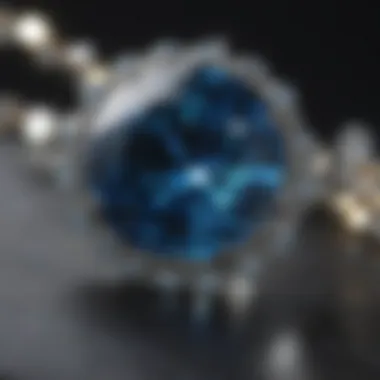Examining the Ethics of Blue Nile Diamonds


Intro
In a world increasingly focused on ethical consumption, the diamond industry is under a microscope, especially concerning how gems like Blue Nile diamonds are sourced and certified. Diamonds have long represented beauty, wealth, and status, but the associated ethical implications have sparked debates that force consumers to reconsider their choices.
The topic at hand includes an in-depth examination of Blue Nile's commitment to ethical practices and what that means in a broader sense. The consumer today is bombarded with information, and knowing the narrative behind these sparkling stones has never been more crucial. This article aims to lay bare the intricate web of sourcing, ethics, and consumer perception.
Understanding the landscape of ethical diamonds begins not only with the gems themselves but with a clear overview of the gemstone category as a whole. Let’s dive into the foundational aspects of gemstones to set the stage.
Preamble to Blue Nile Diamonds
The exploration of Blue Nile diamonds is not merely a dive into the aesthetic beauty of these gems; it also encompasses a layered discussion about the ethical implications of their sourcing and trade. In a world increasingly conscious of ethical consumerism, understanding Blue Nile's approach provides valuable insights into how the jewelry industry can evolve. This section lays the groundwork for comprehending why ethical considerations matter not just for consumers but for the industry as a whole.
Overview of Blue Nile as a Brand
Blue Nile stands out in the expansive landscape of online jewelry retailers. Established in 1999, this Seattle-based company has made a name for itself by providing high-quality diamonds and fine jewelry directly to consumers. The digital approach eliminated the traditional markup associated with brick-and-mortar stores, allowing customers to access a wider selection at competitive prices.
However, Blue Nile isn't just about affordability and quality; they have also placed a strong emphasis on transparency and ethical practices. Shoppers can browse diamonds with detailed information about their origins, certification, and ethical sourcing standards. This level of clarity not just fosters trust among consumers but also aligns with the evolving expectations of a society keen on maintaining ethical standards in every purchase.
The Significance of Ethical Sourcing
Ethical sourcing in the diamond industry shines a spotlight on various pressing issues, including labor practices, environmental considerations, and the socio-economic impacts on mining communities. When diamonds are sourced responsibly, it ensures that the benefits of their sale extend beyond mere profit margins. Instead, it influences the lives of those in the supply chain positively, whether that involves fair wages or funding for local community projects.
The importance of ethical sourcing has become synonymous with responsible consumerism. More than ever, consumers are seeking assurance that their purchases do not contribute to conflict or human suffering. The implications of supporting ethically sourced diamonds are profound; they not only support sustainable practices but also challenge the entire industry to elevate its standards. As consumers become educated about what ethical sourcing entails, retailers like Blue Nile are encouraged to adopt practices that prioritize human rights and environmental stewardship over profit alone.
"When consumers demand ethical sourcing, it sends a clear message to the industry that ethical practices must be a priority for all involved stakeholders."
In summary, understanding Blue Nile diamonds involves recognizing the brand's commitment to ethical sourcing and the broader significance of these practices in the jewelry market. The brand not only commits to providing quality products but also to ensuring that the story behind each diamond contributes to positive change. Through this lens, Blue Nile not only sells diamonds; they help illuminate the path towards a more ethical diamond industry.
Understanding Ethical Diamonds
In today's jewelry market, the concept of ethical diamonds is not just a trend but a critical consideration for consumers and industry players alike. Given the complexities involved in diamond sourcing, understanding what makes a diamond ethical becomes paramount. Ethical diamonds are defined by their journey from mine to market, ensuring that human and environmental factors are handled responsibly. By gaining insight into ethical diamonds, customers not only make informed decisions but also contribute to a larger movement advocating for sustainability and humane practices in the gemstone industry. More than just sparkling gems, these diamonds symbolize a conscientious choice.
Definition of Ethical Diamonds
Ethical diamonds can be characterized as gemstones that are sourced from locations adhering to strict guidelines concerning human rights and environmental stewardship. In essence, these diamonds are mined, processed, and sold in a manner that respects and promotes the welfare of communities involved throughout the supply chain. The certification of ethical diamonds may entail third-party verification, ensuring that all players in the diamond's journey— from miners to retailers—uphold social responsibility principles.
Unlike traditional diamonds that may come with murky backgrounds, ethical diamonds assure consumers that their purchase contributes positively to society. A key element in this definition is the absence of violence, exploitation, and environmental degradation throughout the diamond’s life cycle. When a person wears an ethical diamond, they are not merely flaunting a beautiful stone, but rather making a statement about their values and priorities.
Contrast with Conflict Diamonds
The stark distinction between ethical diamonds and conflict diamonds cannot be overstated. Conflict diamonds, often referred to as blood diamonds, are sourced from regions rife with strife, where profits are funneled into war efforts and human rights abuses. The catastrophic consequences of this type of diamond mining are well-documented, as they contribute to violence, child labor, and widespread poverty. Thus, when individuals choose to support ethical diamonds, they simultaneously reject the darker narratives tied to the diamond industry.
To further elucidate this point, it’s helpful to consider:
- Social Impact: Ethical diamonds foster community well-being, while conflict diamonds perpetuate cycles of violence.
- Environmental Considerations: Ethical sources maintain ecological balance, contrasting sharply with the often destructive practices found in conflict zones.
- Consumer Awareness: The rise in demand for transparency in diamond sourcing has led to increased awareness regarding the implications of conflict diamonds, compelling consumers to demand accountability.


Ultimately, understanding these distinctions arms consumers with knowledge, enabling them to make purchasing decisions that align with their values and support ethical practices in the diamond industry.
"Choosing ethical diamonds means not only investing in a product but also supporting a cause that champions human rights and environmental sustainability."
By valuing ethical diamonds, buyers not only acquire beauty but also participate in a positive global movement.
Blue Nile's Sourcing Practices
Understanding the sourcing practices of Blue Nile is pivotal in grasping the ethical landscape surrounding their diamonds. The journey from mine to market is laden with complexities, and transparency is the thread that weaves trust into this narrative. For gemstone enthusiasts and collectors, knowing where their diamonds originate can mean not only asthetic appreciation but also an alignment with ethical principles.
Blue Nile places significant weight on ethical sourcing by establishing a clear framework that prioritizes supplier relationships. The brand’s commitment to obtaining diamonds that come from conflict-free areas serves as a foundation for consumer confidence. This transparency not only differentiates Blue Nile within a crowded market but also emphasizes a growing realization among buyers that their choices can contribute positively to global issues.
Supplier Transparency
Supplier transparency is a cornerstone of Blue Nile's sourcing strategy. By maintaining open lines of communication with their suppliers, Blue Nile ensures that each diamond's journey can be traced back to its origins. This diligence not only affirms the ethical standing of their products but also cultivates a sense of accountability across the supply chain.
"In a world where consumers increasingly demand clarity, Blue Nile steps up to deliver information that fosters trust."
When consumers know the story behind their diamonds, be it a stone hailing from South Africa or Botswana, it creates a sentimental bond that transcends mere ownership. This practice also creates a ripple effect, as suppliers themselves may aim to uphold high ethical standards, knowing that their clients value this commitment. To illustrate, Blue Nile sources a significant portion of their diamonds from known regions that adhere to responsible mining practices. This vigilance can serve to set a benchmark for the industry at large, pushing others to follow suit.
Compliance with the Kimberley Process
The Kimberley Process Certification Scheme is a key element in Blue Nile’s commitment to ethical sourcing. Implemented to prevent conflict diamonds from entering the market, this initiative provides a framework that enforces transparency and accountability among diamond trading nations. Blue Nile’s adherence to this protocol indicates their dedication not only to ethical standards, but also to fostering sustainable practices in diamond mining.
By collaborating with the Kimberley Process, Blue Nile plays its part in a broader mission to eradicate the scourge of conflict diamonds. The certification process allows consumers to have a renewed assurance that the diamonds they purchase are certified as conflict-free. This approach aligns with growing consumer expectations for ethical purchasing, enhancing the brand's reputation further.
Moreover, compliance with the Kimberley Process encourages the examination and maturation of global supply chain practices, as it places a framework for responsible mining and trade.
In summary, Blue Nile’s sourcing practices embody a commitment to ethical transparency that resonates well with today’s informed consumers, while also promoting progressive change in the diamond industry. Through conscious sourcing and adherence to international standards like the Kimberley Process, Blue Nile has positioned itself as a leader in the move towards a more ethical marketplace.
Ethical Certifications and Standards
The concept of ethical certifications has become a crucial pillar in the diamond industry, especially for brands like Blue Nile that emphasize responsibility in sourcing. These certifications serve as benchmarks, ensuring that jewels are not only beautiful but also ethically acquired. For consumers, understanding these certifications is paramount in making choices that align with their values.
"Certification gives you peace of mind—like having a gold seal on your conscience."
For ethical jewelry, certifications verify that gemstones do not originate from conflict zones. They also reveal the entire supply chain, affirming that labor practices are fair and environmental standards are upheld. This transparency has become a beacon of trust for buyers, who desire to support brands that prioritize ethical practices.
Role of Certifications in Ethical Jewelry
In the realm of ethical jewelry, certifications play not just a supporting role; they act as the main act. They are the watchdogs ensuring that the beauty of the piece does not come at the expense of human rights or ecological degradation. Various associations, such as the Responsible Jewelry Council, have established standards that guide companies in aligning their practices with ethical values.
The benefits are manifold:
- Consumer Awareness: Certifications serve to educate consumers, making them more aware of the potential issues in the diamond trade.
- Market Differentiation: Brands equipped with ethical certifications stand out in a crowded marketplace, attracting customers who prioritize social responsibility.
- Accountability Mechanisms: These certifications provide a framework that fosters accountability, as brands must adhere to established criteria.


The significance is double-edged—a commitment to ethical sourcing not only satisfies the conscientious buyer but also positively impacts the lives of many involved in the gem trade.
Blue Nile's Certifications Explained
Blue Nile’s approach to ethical certifications is thorough and systematic. The brand proudly highlights its commitment to the Kimberly Process, an international standard aimed at preventing conflict diamonds. This process ensures that only diamonds from legitimate sources make their way into the market. However, Blue Nile doesn't stop there; it engages with additional certifications such as the Responsible Jewelry Council and the Fair Trade Gemstones initiative.
These certifications involve rigorous assessments:
- Transparency in Supply Chain: Blue Nile offers insight into the journey of their diamonds, ensuring that every facet from mining to retail is carefully vetted.
- Ethical Labor Practices: The brand’s partnerships are evaluated to ensure they uphold labor rights.
- Environmental Stewardship: Environmental considerations are integral, requiring suppliers to adhere to sustainable practices.
By showcasing these certifications, Blue Nile positions itself as a leader in ethical practices within the industry. They assure consumers that when they purchase diamonds, they are not only investing in something timeless but also contributing to a responsible and fair trade.
As a growing trend, the demand for ethically sourced gemstones continues to rise. Consumers are encouraged to do their research and opt for brands that demonstrate clear commitment to ethical sourcing through recognized certifications.
Consumer Perspectives on Ethics
Understanding how consumers view ethics in the diamond market is paramount for grasping the broader implications of responsible sourcing. Today's buyers are not merely interested in the aesthetic allure of diamonds; they crave a deeper connection to the gemstones they choose. They want to support brands that reflect their ethical values, fostering a sense of societal responsibility. As awareness grows around issues like conflict diamonds and environmental impacts, consumers are increasingly steering their purchasing habits towards ethical practices. This shift represents not just a trend but a fundamental change in the marketplace.
The Importance of Ethical Considerations
In the realm of diamond shopping, ethical considerations have emerged as a cornerstone for many buyers. This significance can be dissected into several dimensions:
- Personal Values: Many individuals prioritize their moral compass over mere aesthetics. Buyers often feel a sense of guilt or unease when purchasing diamonds associated with unethical sourcing. This emotional connection drives the demand for ethical standards.
- Societal Impact: Purchasing behavior has the potential to influence the diamond industry at large. By opting for ethically sourced diamonds, consumers inadvertently pressure companies, like Blue Nile, to adhere to higher standards. The collective choices of consumers—not just individual ones—can lead to significant societal shifts.
- Market Demand: As more people become aware of ethical sourcing practices, the market for ethical diamonds continues to expand. This demand leads to a more diversified market where ethical jewelers can flourish alongside traditional retailers.
For many, choosing an ethical diamond transcends the simple act of buying jewelry; it intertwines with their identity and values.
Purchasing Decisions and Ethical Awareness
When it comes to purchasing decisions, ethical awareness plays a vital role. In this landscape, customers often exhibit behaviors and thought processes that showcase their focus on ethics. Some pertinent aspects include:
- Research-Focused Purchases: More consumers are diving into research about diamonds and their sources before making a purchase. They explore the intricacies of gemstones, inspecting supplier transparency and seeking certifications that confirm ethical practices.
- Word of Mouth and Reviews: Contemporary shoppers rely heavily on reviews and recommendations from peers or influencers who advocate for ethical practices. A single glowing review about a brand's commitment to ethics can sway potential buyers significantly.
- Brand Loyalty: Ethical considerations create a strong sense of loyalty among consumers. When a brand, such as Blue Nile, aligns with their values, they tend to become repeat customers, often advocating for the brand within their social circles.
Industry Trends in Ethical Gemstones
As the jewelry market continues to evolve, the demand for ethical gemstones has surged significantly. This section sheds light on the pivotal trends shaping the industry, particularly in the realm of ethical sourcing and consumer preferences. With increasing awareness of social responsibility, consumers are no longer just purchasing jewelry; they’re buying into values that align with their own. Companies like Blue Nile are at the forefront of this shift, showcasing their commitment to ensuring that their diamonds are not only beautiful but also sourced ethically.
The Growing Demand for Ethical Options
The latest data reveals a marked increase in consumer demand for ethical diamonds and gemstones. Several factors are at play here. First off, a more informed audience is emerging, one that is keenly aware of the implications behind their purchases. The rise of social media has amplified these concerns, as customers share their thoughts and experiences, creating a vibrant dialogue around ethical sourcing.
Recent trends indicate that millennial and Gen Z shoppers, in particular, are willing to pay a premium for ethically sourced products. Here are a few key points that illustrate this growing demand:
- Sustainability Matters: Many buyers now prioritize sustainability. Ethical stones symbolize a commitment to environmental preservation and social justice.
- Transparency is Key: Customers gravitate towards brands that provide clear information on their sourcing and the journey of their gemstones.
- Cultural Shift: There’s been a noticeable shift in cultural attitudes towards luxury goods. Ethics now play a central role in luxury purchases, not just aesthetics.
This demand not only encourages companies like Blue Nile to highlight their ethical practices but also empowers consumers to make conscientious decisions that reflect their values.


Shifts in Consumer Behavior
With the evolving landscape of ethical gemstones, we see nuanced changes in how consumers approach their jewelry shopping experiences. Gone are the days when price and quality were the sole determinants. Now, the ethical footprint of a diamond can significantly influence a consumer's purchasing decision.
Key factors contributing to these shifts include:
- Informed Choices: Nowadays, consumers conduct thorough research before making a purchase. They look for certifications and sourcing practices that assure them that their chosen gemstone echoes their ethical standards.
- Social Influence: Recommendations from peers and influencers shape consumer perceptions. When someone posts a beautiful piece of ethical jewelry online, it not only garners interest but also promotes discussions about responsible purchasing.
- The Emotional Connection: Buyers increasingly seek emotional resonance in their purchases, desiring stones that tell a story of integrity and respect rather than exploitation.
"Consumers are shifting their focus from mere adornment to the meanings behind their purchases. It’s not just jewelry; it’s a statement of values."
Challenges in the Ethical Diamond Market
The journey towards ethical diamond sourcing is riddled with hurdles that can complicate the pursuit of transparency and peace in this sparkling industry. This section sheds light on the intricate challenges that players like Blue Nile face within the broader landscape of ethical gem trading.
Identification of Genuine Ethical Sources
As the demand for ethically obtained diamonds grows, pinpointing genuine sources has become a pressing issue. The market is peppered with claims of ethical practices, making it tough for consumers to differentiate between diamonds that truly have a clean conscience and those that merely sport a label without substance. This situation poses a significant challenge not only for retailers but also for consumers who wish to make informed purchases.
Many diamonds come with certificates, but not all certificates guarantee authenticity. Some sources might obtain certificates through less-than-scrupulous means. It becomes essential for prospective buyers to not just rely on documentation but also delve deeper into a supplier's sourcing practices. Researching the supply chain can help unveil whether the diamonds stem from mines that uphold ethical standards or if they trickle down from conflict-ridden areas where human rights may be compromised.
In response, brands like Blue Nile emphasize the importance of transparency. They often publish detailed information about their sourcing processes and make it accessible to the public. Despite these efforts, customer scrutiny remains vital, and potential buyers need to educate themselves on what to look for in terms of source verification.
Market Responses to Ethical Concerns
As consumers increasingly voice their concerns about ethical sourcing, the market's response has been noteworthy. Jewelers and suppliers have started adapting to this shift in consumer behavior. As a result, we see a rise in initiatives aimed at tackling ethical shortcomings in the diamond supply chain.
Some key responses include:
- Enhanced Transparency: Many companies are now providing traceability for their gemstones, allowing consumers to follow a diamond’s journey from mine to market. This not only builds trust but empowers consumers to make choices aligned with their ethical beliefs.
- Adoption of Ethical Standards: Organizations are setting strict ethical standards that must be adhered to by suppliers. Programs such as the Kimberley Process Certification Scheme serve as frameworks for identifying conflict-free diamonds, despite their limitations.
- Educating Consumers: There is a growing trend of educational campaigns aimed at informing consumers about the implications of their purchases. Retailers are taking the initiative to explain what ethical diamonds are and how consumers can avoid conflict diamonds.
"Supporting ethical sourcing is not just about the diamonds we wear; it's about nurturing an industry that respects human rights and protects the planet."
Despite these positive changes, skepticism remains. Many consumers are concerned about the sincerity behind these market responses, as some initiatives may be driven more by profit motives than a genuine desire to affect change. The challenge lies in ensuring that the ethical improvements are deep-rooted rather than superficial, fostering a market that truly reflects conscientious values and practices.
Closure: The Future of Blue Nile Diamonds
As we peer into the crystal ball of the diamond industry, the path forward for Blue Nile diamonds appears both promising and laden with responsibility. In an age where consumers are increasingly educated about their purchases, the concept of ethical sourcing has transitioned from a mere trend to a pivotal necessity. This evolving landscape means that any company wishing to remain relevant must adapt actively, and Blue Nile has shown their willingness to propel themselves forward in this ethical dialogue.
Assessing Blue Nile's Commitment
Blue Nile has placed ethics at the heart of its operations. The company's commitment to responsible sourcing is underlined by its strong adherence to the Kimberley Process and its partnership with organizations that advocate for sustainable practices. The result? A transparent supply chain that reassures consumers about the origins of their diamonds. This brings about not just peace of mind but also enhanced brand integrity. By striving to ensure every diamond sold is conflict-free, Blue Nile is not just ticking boxes but taking active steps towards reshaping perceptions across the industry.
In addition, continuous engagement with customers has allowed Blue Nile to gather vital feedback. The feedback loop is vital. It keeps them on their toes and helps them evolve based on what consumers want, fostering a positive relationship between the brand and its patrons. A relentless push for improvement and an eye on community impact are two essential elements of Blue Nile's strategy.
Implications for the Broader Industry
The implications of Blue Nile's approach extend far beyond its own operations. In a market often plagued by ambiguity, the company's proactive stance sets a dynamic precedent for others. As ethical consumerism grows, companies across the diamond sector find themselves navigating rocky waters. The pressure to enhance transparency and build ethical practices can no longer be avoided. In fact, competitors may soon find themselves adopting similar values in a bid to avoid becoming obsolete.
"In a marketplace where consumers increasingly demand authenticity and responsibility, sovereignty over sourcing is no longer negotiable. It's a ticket to the game."
Additionally, Blue Nile acts as a beacon for other retailers in the jewelry space. As consumers become savvier and demand greater accountability, they encourage shifts in business models across the board. This ripple effect is something to watch closely, as it could lead to a widespread transformation of sourcing practices within the jewelry and gemstone marketplace.
Ultimately, the journey of Blue Nile diamonds isn’t just a brand’s evolution; it’s representative of an industry grappling with its ethics. As the demand for responsible sourcing rises, Blue Nile is not just participating in the conversation but leading it. The lessons learned and practices adopted here may well become the backbone of a more ethical future in the broader diamond industry.







